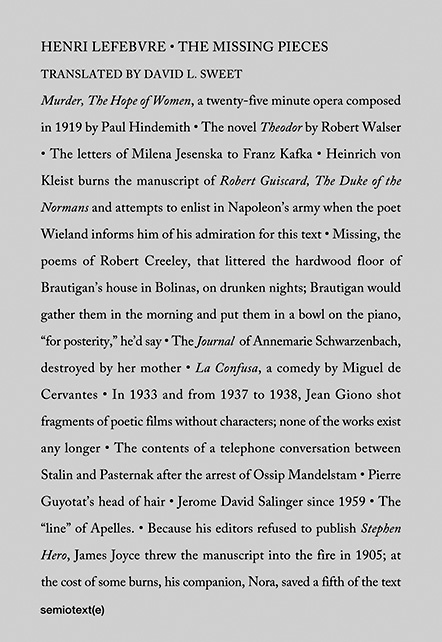The Missing Pieces
May 9, 2016review,
The Missing Pieces, Henri Lefebvre, Semiotext(e), Los Angeles, translated by David L. Sweet, ISBN: 9781584351597, 2014, 88 pages

Burned, destroyed, never completed, not written, hidden, lost, sketched but never continued, possible collaborations never coming to fruition, suicides, forgotten in taxis, eaten by a dog, or non-existent simply because of the inability of their audience to perceive them. The Missing Pieces by writer Henry Lefebvre (to be distinguished from the philosopher) is an imaginary library and a ghostly encyclopaedia that you can easily put in your pocket.
It assumes the form and logic of a list putting together a disparate group of artworks whose only shared feature is their disappearance. A monumental list or rather a list-monument to poems, symphonies, buildings, films, novels, and yes, artists, whose worlds are reduced to the trace of their name, and the circumstances of their disappearance. A list which follows no chronology, an anarchic drift trough different moments in history, and national contexts, not bound to a medium, and forming, perhaps as any list, a disparate group which unfolds as a network of saturated absences. An-archic, that is without a goal or origin, without a claim to establish a coherent narrative that would neatly fit all the (missing) pieces together.
History’s desire is to recapture the fragment, to reconstruct the whole it once belonged to. In contrast, The Missing Pieces forms a constellation of fragments – titles, concepts, projects and ideas irreversibly severed from their works. In this sense, history scatters, or opens as a network in all directions, suspending the linearity of chronology. In contrast to the promise of an archive, that is to deliver the facts of a story, and to reflect a cultural order, this anti-archive invokes the desire to imagine, reconstruct and resonate with pieces that only occupy the modality of an unfinished hypothesis. In a sense this is a catalogue of potentialities, which redraws the histories of music, literature, painting.
The Missing Pieces is also a catalogue of inadvertent iconoclasms, and an anecdotal list of destructions. Still, it has the power to bring the unread novels, destroyed paintings and unwritten poems into existence by the irreversible logic of the trace. Every erasure leaves a presence: the incision of the mute call of the work, or of a work:
‘Henry de Toulouse Lautrec wasted the last two years of his life by not painting.’
‘At age nine, the artist Hans-Peter Feldman burns the photographic portraits of his family in the family garden.’
‘In 1751, Joseph Haydn receives a commission for a comic opera of which not a trace remains; twenty-six other operas followed, eleven of which are lost; his wife, Maria Anna, cut up her husband’s manuscript scores to use as hair curlers.’
‘The Merzbau (1920–1936) by Kurt Schwitters, sculpture-décor constructed in his house in Hanover, is destroyed after he goes into exile.’
The Missing Pieces also poses the terrifying, unanswerable question of storing, archiving and preserving works. It is of course impossible to preserve all works of what we now today call art. They, as all living things, are mortal in a very particular way. Works disappear, and are prone to change. One of the conceptual gestures of the book’s invocation is to invite us to imagine the impossibility of something like a total archive of culture without missing pieces. Or the impossibility of a total memory, which would collapse culture onto an eternal present whose only horizon is reliving the past.
Alena Alexandrova is an Associate Professor at the Bergen Academy of Art and Design and Lecturer at the Gerrit Rietveld Academy, Amsterdam. She obtained her doctoral degree from the University of Amsterdam. She has published internationally in the fields of aesthetics, performance and visual studies and works as an independent curator.